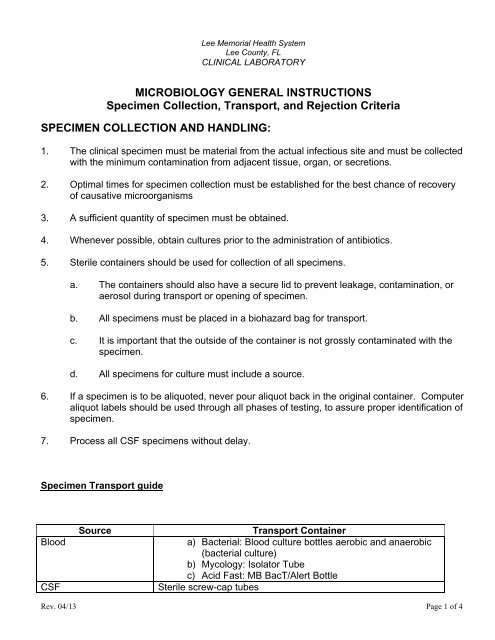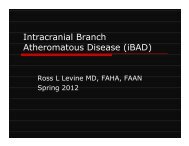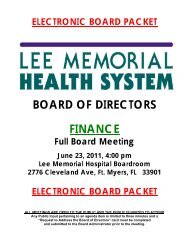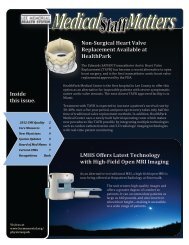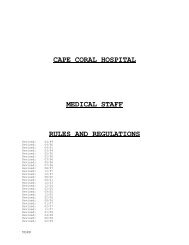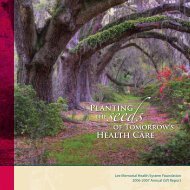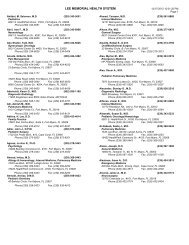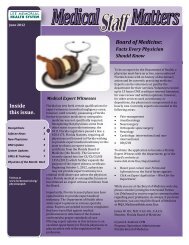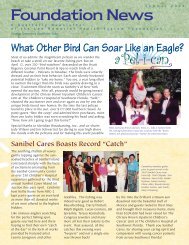Microbiology General Instructions - Lee Memorial Health System
Microbiology General Instructions - Lee Memorial Health System
Microbiology General Instructions - Lee Memorial Health System
Create successful ePaper yourself
Turn your PDF publications into a flip-book with our unique Google optimized e-Paper software.
<strong>Lee</strong> <strong>Memorial</strong> <strong>Health</strong> <strong>System</strong><br />
<strong>Lee</strong> County, FL<br />
CLINICAL LABORATORY<br />
MICROBIOLOGY GENERAL INSTRUCTIONS<br />
Specimen Collection, Transport, and Rejection Criteria<br />
SPECIMEN COLLECTION AND HANDLING:<br />
1. The clinical specimen must be material from the actual infectious site and must be collected<br />
with the minimum contamination from adjacent tissue, organ, or secretions.<br />
2. Optimal times for specimen collection must be established for the best chance of recovery<br />
of causative microorganisms<br />
3. A sufficient quantity of specimen must be obtained.<br />
4. Whenever possible, obtain cultures prior to the administration of antibiotics.<br />
5. Sterile containers should be used for collection of all specimens.<br />
a. The containers should also have a secure lid to prevent leakage, contamination, or<br />
aerosol during transport or opening of specimen.<br />
b. All specimens must be placed in a biohazard bag for transport.<br />
c. It is important that the outside of the container is not grossly contaminated with the<br />
specimen.<br />
d. All specimens for culture must include a source.<br />
6. If a specimen is to be aliquoted, never pour aliquot back in the original container. Computer<br />
aliquot labels should be used through all phases of testing, to assure proper identification of<br />
specimen.<br />
7. Process all CSF specimens without delay.<br />
Specimen Transport guide<br />
Blood<br />
CSF<br />
Source<br />
Transport Container<br />
a) Bacterial: Blood culture bottles aerobic and anaerobic<br />
(bacterial culture)<br />
b) Mycology: Isolator Tube<br />
c) Acid Fast: MB BacT/Alert Bottle<br />
Sterile screw-cap tubes<br />
Rev. 04/13 Page 1 of 4
Gastrointestinal<br />
1. Stool<br />
1.<br />
a) Bacterial: Sterile screw-cap cup or Carey Blair<br />
transport.<br />
b) Ova and parasite Screen:10%formalin<br />
c) Ova and parasite comprehensive: Ecofix<br />
d) C.diff: Screw cap cup<br />
e) Rotavirus: Screw cap cup or culturette<br />
2. Rectal<br />
3. Gastric washing<br />
4. Rectal biopsy<br />
Eye<br />
1. Conjunctival<br />
Scraping<br />
2. Corneal scraping<br />
3. Intraocular fluid<br />
4. Eye<br />
Genital tract, female<br />
1. Amniotic fluid<br />
2. Tissue<br />
2. Culturette<br />
3. Sterile screw-cap or sputum trap cup<br />
4. Sterile screw-cap tube or cup. If specimen is small, add a<br />
small amount of sterile 0.85%saline.<br />
1. Send prepared smears and directly inoculated media.<br />
2. Send prepared smears and directly inoculated media.<br />
3. Vitreous fluid trap or capped syringe without needle with<br />
air expelled.<br />
4. Culturette<br />
1. Sterile screw-cap tube<br />
2. Sterile screw-cap cup<br />
3. Cervical<br />
4. Vaginal<br />
3.<br />
4.<br />
a) Bacterial : Culturette<br />
b) GC/CT DNA Probetec tube<br />
a) Bacterial : Culturette<br />
b) GC/CT DNA Probetec tube<br />
Genital tract, male<br />
1. Anal swab<br />
2. Urethral<br />
Lower respiratory track<br />
1. Lung biopsy<br />
2. Sputums<br />
1. Culturette<br />
2.<br />
a) Bacterial: Culturette<br />
b) GC/CT DNA Probetec tube<br />
1. Sterile screw-cap cup<br />
2. Sterile screw-cap cup or sputum trap<br />
3. Bronchial washing 3. Sterile screw-cap cup or sputum trap<br />
4. BAL<br />
4. Sterile screw-cap cup or sputum trap on ice.<br />
Rev. 04/13 Page 2 of 4
Upper respiratory track<br />
1. Throat<br />
2. Nasal<br />
3. Oral<br />
1. Culturette<br />
2. Culturettte<br />
3. Culturette<br />
4. Naspharyngeal<br />
4.<br />
a) Bacterial: NP Swab<br />
b) Viral: Viral transport media<br />
5. Nasal washing<br />
Sterile body fluids<br />
(excluding CSF, Blood<br />
and urine)<br />
Subcutaneous skin<br />
Site wound<br />
Deep wound or<br />
abscesses<br />
Soft tissue aspirates<br />
Tissue<br />
Bone<br />
Urine<br />
5. Screw-cap cup or syringe without<br />
Needle.<br />
Sterile screw-cap cup or blood culture bottles<br />
Culturette<br />
Culturette<br />
Sterile screw-cap container or tube<br />
Capped syringe without needle<br />
Sterile screw-cap container or tube with saline<br />
Sterile container, if specimen small add small amount of sterile<br />
saline to container.<br />
Bacterial: Boric acid urine collection tube or sterile cup.<br />
GC/CT DNA- Probetec urine collection device<br />
Specimen Rejection Criteria<br />
1. Unlabeled or mislabeled specimen.<br />
a. Refer to policy 7.A.002.S Specimen Rejection.<br />
2. Duplicate specimen:<br />
a. Most duplicate specimens received on the same date should not be processed,<br />
exceptions include blood cultures, CSF, tissues and sterile body fluids.<br />
3. Leaky containers:<br />
a. A specimen is unacceptable when the outside of the container is grossly<br />
contaminated with the specimen.<br />
b. If the container is leaking, set up the specimen only if it is possible to process without<br />
contaminating the processor.<br />
Rev. 04/13 Page 3 of 4
4. Contaminated specimen:<br />
a. Do not process a specimen if it is contaminated with another type of specimen. For<br />
example, a urine should not contain stool, and vice versa.<br />
5. Unacceptable specimens:<br />
a. Do not accept saliva in place of sputum for culture as out lined in Respiratory Culture<br />
procedure.<br />
b. Foley catheter tips are unacceptable for culture.<br />
c. Twenty-four hour urines specimens are unacceptable for bacterial cultures<br />
d. Specimens submitted in a collection devise that has not been used to validate the<br />
procedure.<br />
e. Specimen types that have not been validated for the procedure.<br />
f. Urine for CT/GC DNA must be in Probetec urine transport tube within five hours after<br />
collection of urine.<br />
g. Gastric aspirates for acid fast culture must be processed with in 4 hours after<br />
collection unless sodium bicarbonate is added to the specimen.<br />
h. Stool specimens for bacterial culture are not accepted from inpatients after the third<br />
hospital day, without prior consultation. Also no more than two specimens/per patient<br />
without prior consult.<br />
i. Stool specimens for Ova and Parasites are not accepted from inpatients after the<br />
third hospital day, without prior consultation. Also no more that three specimens/per<br />
patient without prior consult.<br />
j. Formed stool specimen for C.diff PCR testing is not acceptable.<br />
k. CT/GC DNA collected with a wooden swab is not acceptable.<br />
l. Tissue specimen for cultures submitted in formalin is not acceptable.<br />
6. Delay in transport<br />
a. When a suboptimal specimen is processed, a comment should be made on the<br />
patients report to inform the physician. Examples of these comments are:<br />
i. Specimen received in unsterile container.<br />
ii. Microorganisms isolated may not reflect actual microbiota because of faulty<br />
collection and/or transportation.<br />
Approved By: ________________________________ Date: _______________<br />
Approved By: ________________________________ Date: _______________<br />
Rev. 04/13 Page 4 of 4


